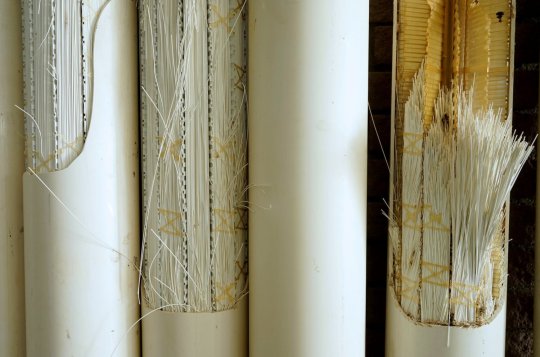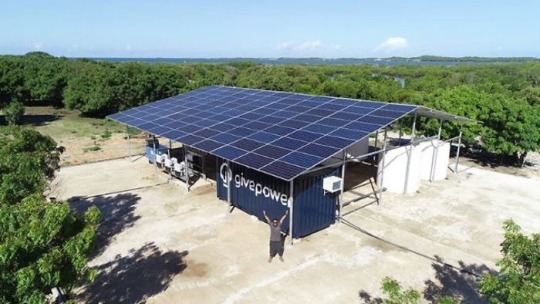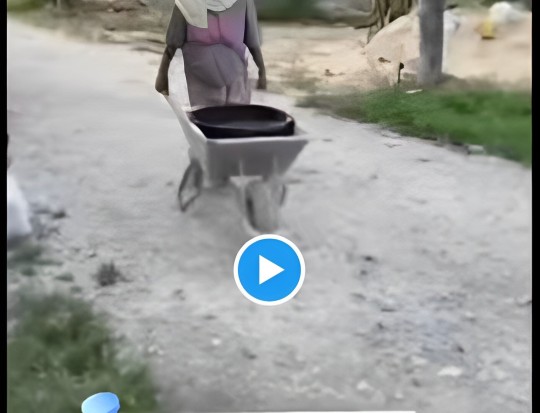#potable water
Text
"Namibia is the driest country in Sub-Saharan Africa, and home to two of the world’s most ancient deserts, the Kalahari and the Namib. The capital, Windhoek, is sandwiched between them, 400 miles away from the nearest perennial river and more than 300 miles away from the coast. Water is in short supply.
It’s hard to imagine life thriving in Windhoek, yet 477,000 people call it home, and 99 per cent of them have access to drinking water thanks to technology pioneered 55 years ago on the outskirts of the city. Now, some of the world’s biggest cities are embracing this technology as they adapt to the harshest impacts of climate change. But Namibia leads the way.
How did this come about? In the 1950s, Windhoek’s natural resources struggled to cope with a rapidly growing population, and severe water shortages gripped the city. But disaster forced innovation, and in 1968 the Goreangab Water Reclamation Plant in Windhoek became the first place in the world to produce drinking water directly from sewage, a process known as direct potable reuse (DPR).
That may sound revolting, but it’s completely safe. Dr Lucas van Vuuren, who was among those who pioneered Windhoek’s reclamation system, once said that “water should not be judged by its history, but by its quality”. And DPR ensures quality.
This is done using a continuous multi-barrier treatment devised in Windhoek during eight years of pilot studies in the 1960s. This process – which has been upgraded four times since 1968 – eliminates pollutants and safeguards against pathogens by harnessing bacteria to digest the human waste and remove it from the water. This partly mimics what happens when water is recycled in nature, but Windhoek does it all in under 24 hours...

Pictured: These ultrafiltration membranes help to remove bacteria, viruses and pathogens. Image: Margaret Courtney-Clarke
“We know that we have antibiotics in the water, preservatives from cosmetics, anti-corrosion prevention chemicals from the dishwasher,” Honer explains. “We find them and we remove them.”
Honer adds that online instruments monitor the water continuously, and staff ensure that only drinking water that meets World Health Organisation (WHO) guidelines is sent to homes. If any inconsistencies are detected, the plant goes into recycle mode and distribution is halted until correct values are restored.
“The most important rule is, and was, and always will be ‘safety first’,” says Honer. The facility has never been linked to an outbreak of waterborne disease, and now produces up to 5.5m gallons of drinking water every day – up to 35 per cent of the city’s consumption.
Namibians couldn’t survive without it, and as water shortages grip the planet, Windhoek’s insights and experience are more important than ever.
Interest from superpowers across the globe
In recent years, delegations from the US, France, Germany, India, Australia, Singapore, and the United Arab Emirates have visited Windhoek seeking solutions to water shortages in their own countries.
Megadrought conditions have gripped the US since 2001, and the Colorado River – which provides 40 million people with drinking water – has been running at just 50 per cent of its traditional flow. As a result, several states including Texas, California, Arizona and Colorado are beginning to embrace DPR.
Troy Walker is a water reuse practice leader at Hazen and Sawyer, an environmental engineering firm helping Arizona to develop its DPR regulations. He visited Windhoek last year. “It was about being able to see the success of their system, and then looking at some of the technical details and how that might look in a US facility or an Australian facility,” he said. “[Windhoek] has helped drive a lot of discussion in industry. [Innovation] doesn’t all have to come out of California or Texas.”

Pictured: The internal pipes and workings of Namibia's DPR plant. As water becomes scarcer in some parts, countries are looking to DPR for solutions. Image: Margaret Courtney-Clarke
Namibia has also helped overcome the biggest obstacle to DPR – public acceptance. Disgust is a powerful emotion, and sensationalist ‘toilet to tap’ headlines have dismantled support for water reuse projects in the past. Unfortunately, DPR’s biggest strength is also its biggest weakness, as the speed at which water can re-enter the system makes it especially vulnerable to prejudice, causing regulators to hesitate. “Technology has never been the reason why these projects don’t get built – it’s always public or political opposition,” says Patsy Tennyson, vice president of Katz and Associates, an American firm that specialises in public outreach and communications.
That’s why just a handful of facilities worldwide are currently doing DPR, with Windhoek standing alongside smaller schemes in the Philippines, South Africa and a hybrid facility in Big Spring, Texas. But that’s all changing. Drought and increased water scarcity worldwide are forcing us to change the way we think about water.
Now, the US is ready to take the plunge, and in 2025, El Paso Water will begin operating the first ‘direct to distribution’ DPR facility in North America, turning up to 10m gallons of wasterwater per day into purified drinking water – twice as much as Windhoek. San Diego, Los Angeles, California, as well as Phoenix, Arizona are also exploring the technology."
Of course, DPR is not a silver bullet in the fight against climate change. It cannot create water out of thin air, and it will not facilitate endless growth. But it does help cities become more climate resilient by reducing their reliance on natural sources, such as the Colorado River.
As other nations follow in Namibia’s footsteps, Windhoek may no longer take the lead after almost six decades in front.
“But Windhoek was the first,” Honer reminds me. “No one can take that away.”"
-via Positive.News, August 30, 2023
#namibia#africa#desert#water shortage#water conservation#dpr#potable water#water recycling#clean water#drought#united states#colorado river#science and technology#sanitation#good news#hope
2K notes
·
View notes
Text
Nothing to see here, just 20 million people whose access to a safe water supply has been obliterated by flooding, carry on.
60 notes
·
View notes
Text

📍Iserables, Switzerland
20 notes
·
View notes
Text

NBMN
Kenya Has Installed Its First Solar Powered Plant That Turns Ocean Water Into Drinking Water
#black diaspora news#black diaspora#kenya#water#solar power#solar panels#drinking water#africa#tech#potable water
1 note
·
View note
Text
Let’s look at how China & India have been dealing with overpopulation & managing feeding/housing/education/employment/transportation/healthcare.
What areas have they made good choices that are sustainable? What areas have failed or are causing additional unforeseen problems?
How can we be forward thinking & apply wisdom as a country to prepare for the inevitable?
Why not move towards mass transit instead of a hard push for electric cars?
What resources are we wasting or need to have a better management system in place?
Are any municipalities setting a great example?
Can we switch en mads to grey water in our toilets?
(Because why are we shitting & pissing in potable water? )
Can we talk about and brainstorm these things topics/issues?
What are your thoughts? Ideas?
Can we put our heads together instead of making everything a bipartisan battle?
I’d like to meet more people who are thinking about these things.
#the future#resource management#sustainsble practices#china#overpopulation#foresight#mass transit#electric cars#potable water#universal issues#wise planning#smart evonomy#economic stability#let’s talk
1 note
·
View note
Text
Water distillation
Disclaimer: This is not a topic I'm super familiar with. So, I'm going to send you elsewhere for information about it.
Healthline article about distilled water, and it's pros and cons. Click the following link: https://www.healthline.com/health/can-you-drink-distilled-water
How to distill your own water, disaster DIY edition:
Distilled water is the collection of evaporated steam water. There are several ways to collect this steam water, depending on the tools you have on hand. I recommend doing a search and taking notes on as many different methods as you can find. You never know where you'll be or what resources you'll have on hand for distilling water.
PS if you see someone collecting steam into a ziplock bag, please note, it needs to be a ziplock Freezer bag! Non-freezer ziplock bags will melt.
#water filtration#water purification#disaster preparation#water distillation#potable water#community prepper#prepper
0 notes
Text
Practice English
The US Army Corps of Engineers is planning to barge 36 million gallons of freshwater daily into the lower Mississippi River near New Orleans as saltwater intrusion from the Gulf of Mexico continues to threaten drinking water supply, officials said Friday.
— Read on amp.cnn.com/cnn/2023/09/23/us/freshwater-new-orleans-saltwater-mississippi-river/index.html
View On WordPress
#Army Corps of Engineers#English as a Second Language#ESL#New Orleans#Potable Water#practice English
0 notes
Text
youtube
1 note
·
View note
Text
This is How Kelantanese Get Their Potable Water
PAS attacks PM Anwar Ibrahim for the economic, social and water woes of Kelantan. But PAS is ruling the state, and has no plans or brains on how to solve the issues. Right? The Kelantanese love them?
Water Woes
Now see how the citizens of Kelantan are using their ingenuity – of course, they are forced to – to get potable water. This is Malaysia in 2023 folks and if you want to see that in…

View On WordPress
0 notes
Link
Ohangwena region deserves opportunities that other regions are enjoying, Popular Democratic Movement parliamentarian Lukas Hamata said in his contribution on the appropriation bill in parliament on Wednesday.
He said Ohangwena is one of the largest regions by population, yet the poorest and least developed.
“The Ohangwena region is faced with a number of socio-economic challenges, such as unemployment, gender-based violence, income inequalities, housing needs, poor sanitation, poor road infrastructure and [a lack of] access to potable water,” Hamata said.
According to Hamata, although Ohangwena is blessed with underground water that is enough to be used for 400 years, the government has neglected the region for years.
“In the 2022/2023 medium-term expenditure framework, the Ohangwena region received the fifth lowest developmental budget allocation, despite being the second highest populated region in Namibia. This speaks volumes on how the region is disregarded in terms of developmental priorities,” he said.
#electricity#roads#housing#sanitation#GBV#potable water#Ohangwena#Namibia#news#via Energy100FM#world news
0 notes
Text
putting my prediction on record now that the coming decade is going to see the rise of viral-marketed fancy at-home water filtration systems, driving and driven by a drastic reduction in the quality of U.S. tap water (given that we are in a 'replacement era' where our current infrastructure is reaching the end of its lifespan--but isn't being replaced). also guessing that by the 2030s access to drinkable tap water will be a mainstream class issue, with low-income & unstably housed people increasingly forced to rely on expensive bottled water when they can't afford the up-front cost of at-home filtration--and with this being portrayed in media as a "moral failing" and short-sighted "choice," rather than a basic failure of our political & economic systems. really hope i'm just being alarmist, but plenty of this already happens in other countries, and the U.S. is in a state of decline, so. here's praying this post ages into irrelevance. timestamped April 2023
#apollo don't fucking touch this one#serious post#not a shitpost#hope i forget about this post and have no reason to ever look back on it one day#fyi i'm aware that access to potable water is already a major issue in parts of the U.S. yes i know flint michigan exists#i'm saying that this issue is going to GROW unless local & federal governments work together to fix it.#so it's a matter of if we trust them to fix it. And well--do you?#what are the chances the government just denies there's a problem until the water actually turns brown#at which point it's already been common knowledge for years and people have just become resigned and that's our new normal#i'm mean come on. how many of us already believe that we're being exposed to dangerous pollutants we don't know about and can't avoid#like that's pretty much just part of being a modern consumer. accepting that companies will happily endanger your life for a few pennies#and the most you'll get is like a $50 gift card as part of a class action rebate 20 years down the line#probably the history books will look back on Flint as a warning and a harbinger that went ignored#luxury condos will advertise their built-in top-of-the-line filtration systems--live here and you can drink water straight from your tap!#watch the elite professional class putting $700 dyson water filtration systems on their wedding registry#while the rest of us figure out how to fit water delivery into our grocery budget while putting 90% of our paycheck towards rent#also eggs are $15
5K notes
·
View notes
Text
Access to water: What price are women and girls really paying?, By Arit Oku
Access to water: What price are women and girls really paying?, By Arit Oku
“Sex for Water: What Price Are Women Paying?”…The challenges are a result of acute water shortages in recent times due to “changing weather patterns and aging facilities.” Males in control of water sources and access began to proposition girls for sex (not only money) in exchange for water, especially at night. Girls who reject their overtures are forced to return without water and some of the…

View On WordPress
#Access to water#Arit Oku#Gender burden of access to water#girls#Potable water#The Gender Channel#women
0 notes
Text



(x)
#metal gear#metal gear solid#mgs#kazuhira miller#venom snake#vkaz#friend sent me this reel saying it's Kaz asking Bibo#But u see. Bibo wouldn't care#nor would he even acknowledge there's potable & non-potable water#it's definitely Venom
460 notes
·
View notes
Text
Apparently there has been a new publishing debut drama dust devil, and every time one crops up, three things come to mind. (Apart from the desire to slam my hand in a car door before any more of it is explained to me.)
Being a debut is a lot like being slammed right back into your teenage years. Everything feels bigger, more important, more personal, like you have to break out or your (publishing) life will be over. This is particularly bad in YA, because of the pressure on YA authors to build and leverage social media platforms with little to no publisher guidance or support. Eventually you're gonna look back at the time spent on petty shit and realize how much of a waste it all was, and how bad it was for your mental health.
People are going to invent the version of you they want to engage with, for good and bad. It's not uncommon for bad faith pile-ons to spiral out of control because they give spectators a seemingly abstract outlet for day to day frustrations. It's also not uncommon for people to defend bad actions from someone they have a lot in common with. At the end of the day, all that can speak for you is your work. It's slower and harder than tiktoks and ukulele videos, but it also outlasts them by decades.
If you want to write books for a career, odds are that you are going to be asked to do events and panels and discussions with people from all over publishing. Including people you dislike, people you and/or your friends have been cruel to, people who have been cruel to you or your friends, people whose work you don't respect, and/or people who you simply find annoying. Publishing is, sometimes by design, a constantly moving target, and plenty of people inside and out are willing to treat it like a reality TV episode. But the one constant I've found is that people will never forget how you made them feel. This doesn't mean "be nice to racists," btw. It means you can never go wrong with acting like a professional instead of a Kardashian.
#publishing rambles#it's just so very rarely worth the energy#maybe it's just that I'm 37 and I ration my attention span like a post-apocalyptic forager with their last canteen of potable water#being an asshole does not write your next book
84 notes
·
View notes
Text
28 notes
·
View notes
Text
Toxic Algae Blooms in Water Sources
What can you do?
Unless you are a municipal water district with really expensive water cleaning equipment, pretty much nothing. Don't touch it!
Us lesser-equipped beings do not have the means to successfully filter nor purify this hazardous water. Neither bleach, nor boil, nor pressing through fine filters will remove the danger presented by a toxic algae bloom. (Which, by the way, is a total misnomer. That stuff is not even algae. It is a cyanobacteria. Alas, language, that imperfect construct. *shakes fist*)
This stuff is serious. Don't drink it. Don't walk or swim in it. Don't let your pets have contact with it. Toxic bloom-contaminated water can permanently disable you, and even end your life.
Ok, but you're out in the wilderness, literally dying of thirst! The only water source within survivable distance is contaminated with a toxic algae bloom. However, you discover clear spot in the contaminated body of water, where the algae doesn't appear to have spread. What to do? Well, you have to decide your risks for yourself. On the one hand, death by dehydration. On the other hand, potential disability or death. Nobody but you can make that choice for you.
So, now that we know it's dangerous, where does this stuff usually occur and what does it look like?
During an email conversation about blooms and alpine lakes, an anonymous person had this to say about it:
"Cyanobacteria blooms are prompted by late summer lake stratification and amplified primary productivity exacerbated by excess nutrients. We tend to see toxic blooms concentrated in areas of development, where shoreline septic systems, gardening or farming create nutrient rich runoff into the lake environment.
That being said it is not completely impossible for a cyanobacteria bloom to occur in an alpine lake."
To look at images of toxic algae bloom, follow this link: https://www.nwtoxicalgae.org/Gallery.aspx
#water purification#water filtration#toxic algae bloom#cyanobacteria#backpacking#potable water#disaster preparation#community prepper#prepper
0 notes